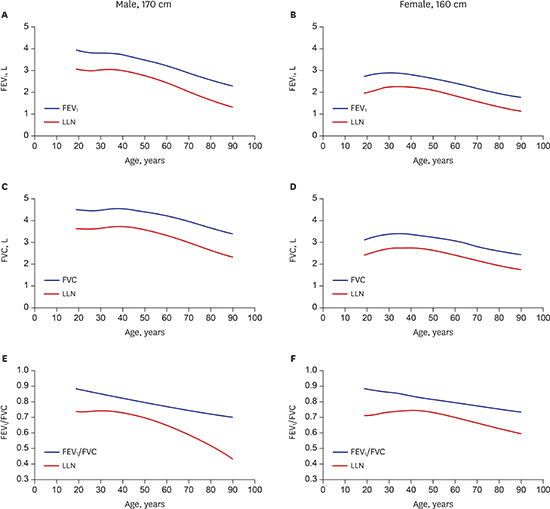1. Miller MR, Hankinson J, Brusasco V, Burgos F, Casaburi R, Coates A, et al. Standardisation of spirometry. Eur Respir J. 2005; 26(2):319–338.
2. Pellegrino R, Viegi G, Brusasco V, Crapo RO, Burgos F, Casaburi R, et al. Interpretative strategies for lung function tests. Eur Respir J. 2005; 26(5):948–968.
3. Global strategy for the diagnosis, management, and prevention of chronic obstructive pulmonary disease. Updated 2017. Accessed June 20, 2017.
http://www.goldcopd.org.
4. van Dijk W, Tan W, Li P, Guo B, Li S, Benedetti A, et al. Clinical relevance of fixed ratio vs lower limit of normal of FEV1/FVC in COPD: patient-reported outcomes from the CanCOLD cohort. Ann Fam Med. 2015; 13(1):41–48.

5. Güder G, Brenner S, Angermann CE, Ertl G, Held M, Sachs AP, et al. GOLD or lower limit of normal definition? A comparison with expert-based diagnosis of chronic obstructive pulmonary disease in a prospective cohort-study. Respir Res. 2012; 13(1):13.

6. Lung function testing: selection of reference values and interpretative strategies. American Thoracic Society. Am Rev Respir Dis. 1991; 144(5):1202–1218.
7. Culver BH. How should the lower limit of the normal range be defined? Respir Care. 2012; 57(1):136–145.

8. Xu X, Laird N, Dockery DW, Schouten JP, Rijcken B, Weiss ST. Age, period, and cohort effects on pulmonary function in a 24-year longitudinal study. Am J Epidemiol. 1995; 141(6):554–566.

9. Kubota M, Kobayashi H, Quanjer PH, Omori H, Tatsumi K, Kanazawa M, et al. Reference values for spirometry, including vital capacity, in Japanese adults calculated with the LMS method and compared with previous values. Respir Investig. 2014; 52(4):242–250.

10. Stanojevic S, Wade A, Cole TJ, Lum S, Custovic A, Silverman M, et al. Spirometry centile charts for young Caucasian children: the Asthma UK Collaborative Initiative. Am J Respir Crit Care Med. 2009; 180(6):547–552.

11. Stanojevic S, Wade A, Stocks J, Hankinson J, Coates AL, Pan H, et al. Reference ranges for spirometry across all ages: a new approach. Am J Respir Crit Care Med. 2008; 177(3):253–260.
12. Quanjer PH, Stanojevic S, Cole TJ, Baur X, Hall GL, Culver BH, et al. Multi-ethnic reference values for spirometry for the 3–95-yr age range: the global lung function 2012 equations. Eur Respir J. 2012; 40(6):1324–1343.

13. Kweon S, Kim Y, Jang MJ, Kim Y, Kim K, Choi S, et al. Data resource profile: the Korea National Health and Nutrition Examination Survey (KNHANES). Int J Epidemiol. 2014; 43(1):69–77.

14. McMahon T. Size and shape in biology. Science. 1973; 179(4079):1201–1204.
15. Rigby RA, Stasinopoulos DM. Generalized additive models for location, scale and shape. J R Stat Soc Ser C Appl Stat. 2005; 54(3):507–554.
16. Cole TJ, Green PJ. Smoothing reference centile curves: the LMS method and penalized likelihood. Stat Med. 1992; 11(10):1305–1319.

17. Eom SY, Kim H. Reference values for the pulmonary function of Korean adults using the data of Korea National Health and Nutrition Examination Survey IV (2007–2009). J Korean Med Sci. 2013; 28(3):424–430.

18. Cole TJ, Stanojevic S, Stocks J, Coates AL, Hankinson JL, Wade AM. Age- and size-related reference ranges: a case study of spirometry through childhood and adulthood. Stat Med. 2009; 28(5):880–898.

19. Choi JK, Paek D, Lee JO. Normal predictive values of spirometry in Korean population. Tuberc Respir Dis. 2005; 58(3):230–242.

20. Hankinson JL, Odencrantz JR, Fedan KB. Spirometric reference values from a sample of the general U.S. population. Am J Respir Crit Care Med. 1999; 159(1):179–187.

21. Morris JF, Koski A, Johnson LC. Spirometric standards for healthy nonsmoking adults. Am Rev Respir Dis. 1971; 103(1):57–67.

22. Wu Y, Zhang Z, Gang B, Love EJ. Predictive equations for lung function based on a large occupational population in North China. J Occup Health. 2009; 51(6):471–477.

23. Ip MS, Karlberg EM, Karlberg JP, Luk KD, Leong JC. Lung function reference values in Chinese children and adolescents in Hong Kong. I. Spirometric values and comparison with other populations. Am J Respir Crit Care Med. 2000; 162(2 Pt 1):424–429.
24. Ip MS, Ko FW, Lau AC, Yu WC, Tang KS, Choo K, et al. Updated spirometric reference values for adult Chinese in Hong Kong and implications on clinical utilization. Chest. 2006; 129(2):384–392.

25. Pan WH, Chen JY, Haung SL, Liou TL, Lee TK, Wang LY, et al. Reference spirometric values in healthy Chinese neversmokers in two townships of Taiwan. Chin J Physiol. 1997; 40(3):165–174.
26. Dejsomritrutai W, Nana A, Maranetra KN, Chuaychoo B, Maneechotesuwan K, Wongsurakiat P, et al. Reference spirometric values for healthy lifetime nonsmokers in Thailand. J Med Assoc Thai. 2000; 83(5):457–466.
27. Zhang QL, Zheng JP, Yuan BT, He H, Wang J, An JY, et al. Feasibility and predicted equations of spirometry in Shenzhen preschool children. Zhonghua Er Ke Za Zhi. 2005; 43(11):843–848.
28. Eom SY, Moon SI, Yim DH, Lee CH, Kim GB, Kim YD, et al. Goodness-of-fits of the spirometric reference values for Koreans and USA caucasians to spirometry data from residents of a region within Chungbuk province. Tuberc Respir Dis. 2012; 72(3):302–309.

29. Tanner JM, Hayashi T, Preece MA, Cameron N. Increase in length of leg relative to trunk in Japanese children and adults from 1957 to 1977: comparison with British and with Japanese Americans. Ann Hum Biol. 1982; 9(5):411–423.

30. Morgan SL. Richer and taller: stature and living standards in China, 1979–1995. China J. 2000; (44):1–39.

31. Etler DA. Recent developments in the study of human biology in China: a review. Hum Biol. 1992; 64(4):567–585.
32. Ashizawa K, Tanamachi N, Kato S, Kumakura C, Zhou X, Jin F, et al. Growth of height and leg length of children in Beijing and Xilinhot, China. Anthropol Sci. 2008; 116(1):67–76.

33. Weitz CA, Garruto RM, Chin CT, Liu JC. Morphological growth and thorax dimensions among Tibetan compared to Han children, adolescents and young adults born and raised at high altitude. Ann Hum Biol. 2004; 31(3):292–310.









 PDF
PDF Citation
Citation Print
Print





 XML Download
XML Download